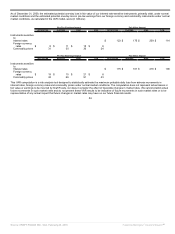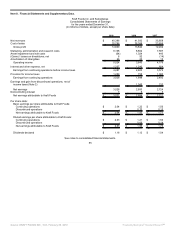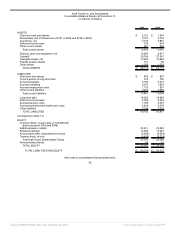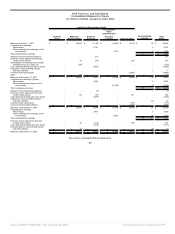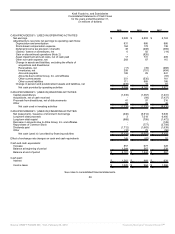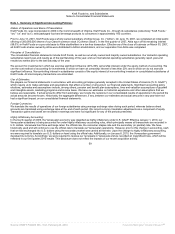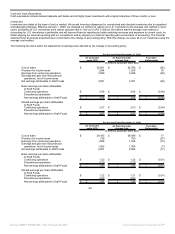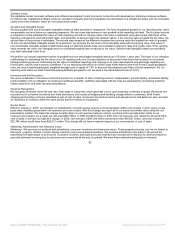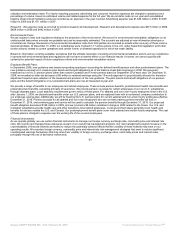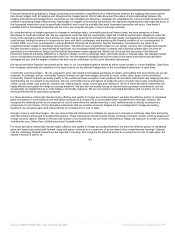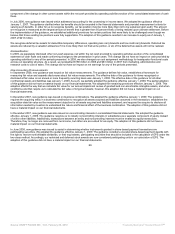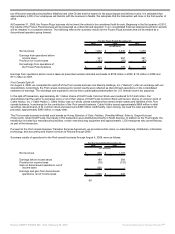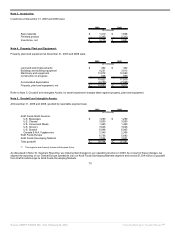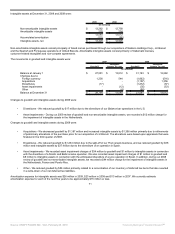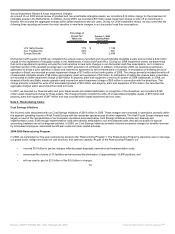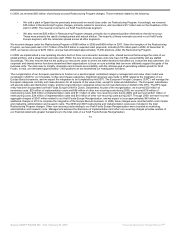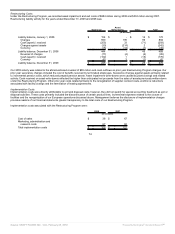Kraft 2009 Annual Report Download - page 67
Download and view the complete annual report
Please find page 67 of the 2009 Kraft annual report below. You can navigate through the pages in the report by either clicking on the pages listed below, or by using the keyword search tool below to find specific information within the annual report.
Financial instruments qualifying for hedge accounting must maintain a specified level of effectiveness between the hedging instrument and the
item being hedged, both at inception and throughout the hedged period. We formally document the nature of and relationships between the
hedging instruments and hedged items, as well as our risk management objectives, strategies for undertaking the various hedge transactions and
method of assessing hedge effectiveness. Additionally, for hedges of forecasted transactions, the significant characteristics and expected terms of
the forecasted transaction must be specifically identified, and it must be probable that each forecasted transaction will occur. If we deem it
probable that the forecasted transaction will not occur, we recognize the gain or loss in earnings currently.
By using derivatives to hedge exposures to changes in exchange rates, commodity prices and interest rates, we have exposure on these
derivatives to credit and market risk. We are exposed to credit risk that the counterparty might fail to fulfill its performance obligations under the
terms of the derivative contract. We minimize our credit risk by entering into transactions with high quality counterparties with investment grade
credit ratings, limiting the amount of exposure we have with each counterparty and monitoring the financial condition of our counterparties. In
October 2008, one of our counterparties, Lehman Brothers Commercial Corporation, filed for bankruptcy. Consequently, we wrote off an
insignificant asset related to derivatives held with them. This did not have a significant impact on our foreign currency risk management program.
We also maintain a policy of requiring that all significant, non-exchange traded derivative contracts with a duration greater than one year be
governed by an International Swaps and Derivatives Association master agreement. Market risk is the risk that the value of the financial
instrument might be adversely affected by a change in foreign currency exchange rates, commodity prices or interest rates. We manage market
risk by incorporating monitoring parameters within our risk management strategy that limit the types of derivative instruments and derivative
strategies we use, and the degree of market risk that may be undertaken by the use of derivative instruments.
We record derivative financial instruments at fair value in our consolidated balance sheets as either current assets or current liabilities. Cash flows
from hedging instruments are classified in the same manner as the affected hedged item in the consolidated statements of cash flows.
Commodity cash flow hedges - We are exposed to price risk related to forecasted purchases of certain commodities that we primarily use as raw
materials. Accordingly, we use commodity forward contracts as cash flow hedges, primarily for meat, coffee, dairy, sugar, cocoa and wheat.
Commodity forward contracts generally qualify for the normal purchase exception under guidance for derivative instruments and hedging activities,
and therefore are not subject to its provisions. We use commodity futures and options to hedge the price of certain input costs, including dairy,
coffee, cocoa, wheat, corn products, soybean oils, meat products, sugar, natural gas and heating oil. Some of these derivative instruments are
highly effective and qualify for hedge accounting treatment. We also sell commodity futures to unprice future purchase commitments, and we
occasionally use related futures to cross-hedge a commodity exposure. We are not a party to leveraged derivatives and, by policy, do not use
financial instruments for speculative purposes.
For those derivative instruments that are highly effective and qualify for hedge accounting treatment, we defer the effective portion of unrealized
gains and losses on commodity futures and option contracts as a component of accumulated other comprehensive earnings / (losses). We
recognize the deferred portion as a component of cost of sales when the related inventory is sold. Ineffectiveness is directly recorded as a
component of cost of sales. For the derivative instruments that we consider economic hedges but do not designate for hedge accounting
treatment, we recognize gains and losses directly as a component of cost of sales.
Foreign currency cash flow hedges - We use various financial instruments to mitigate our exposure to changes in exchange rates from third-party
and intercompany actual and forecasted transactions. These instruments include forward foreign exchange contracts, foreign currency swaps and
foreign currency options. Based on the size and location of our businesses, we use these instruments to hedge our exposure to certain currencies,
including the euro, Swiss franc, British pound and Canadian dollar.
For those derivative instruments that are highly effective and qualify for hedge accounting treatment, we defer the effective portion of unrealized
gains and losses associated with forward, swap and option contracts as a component of accumulated other comprehensive earnings / (losses)
until the underlying hedged transactions are reported in earnings. We recognize the deferred portion as a component of cost of sales when the
related inventory is sold or as
64
Source: KRAFT FOODS INC, 10-K, February 25, 2010 Powered by Morningstar® Document Research℠


